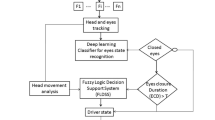Abstract
In this paper a fuzzy expert system for the prediction of hypovigilance-related accidents is presented. The system uses physiological modalities in order to detect signs of extreme hypovigilance. An advantage of such a system is its extensibility regarding the physiological modalities and features that it can use as inputs. In that way, even though at present only eyelid-related features are exploited, in the future and for prototypes designed for professionals other physiological modalities, such as EEG can be easily integrated into the existing system in order to make it more robust and reliable.




Similar content being viewed by others
References
Akerstedt et al (2002) Work organisation and unintentional sleep: results from the WOLF study. Occup Environ Med 59:595–600
Dinges DF, Mallis MM et al (1998) Evaluation of techniques for ocular measurement as an index of fatigue and the basis for alertness management. Final report for the USDOT, NHTSA, 104pp, Report No. DOT HS 808 762
Peters B, Anund A, Östlund J, Hjälmdahl M (2005) Results of Sensation Pilot 2.5–WP1.7 (Alertness Monitoring Database), SENSATION internal deliverable
Rechtschaffen A, Kales A (1968) A manual of standardised terminology, techniques and scoring system for sleep stages of human subjects. US Department of Health, Education and Welfare, Public Health Service, Bethesda
Galley N, Schleicher R, Galley L “Blink parameter for sleepiness detection” and other works by the same authors
Caffier PP, Erdmann U, Ullsperger P (2003) Experimental evaluation of eye-blink parameters as a drowsiness measure. Eur J Appl Physiol 89:319–325
Damousis Y, Tzovaras D (2004) Correlation between SP1 data and parameters and WP 4.4.2 algorithms, Sensation Internal Report (Draft Nov 2004)
Michalewicz Z (1996) Genetic Algorithms + Data Structures = Evolution Programs, New York/USA. Springer-Verlag, Heidelberg
Herrera F, Lozano M, Verdegay JL (1995) Tuning fuzzy controllers by genetic algorithms. Int J Approx Reasoning 12:299–315
Alex H. Bullinger et al (2004) Criteria and algorithms for physiological states and their transitions, SENSATION_Del_1_1_1.doc. SENSATION Deliverable 1.1.1, August 2004
Ji Q, Zhu Z, Lan P (2004) Real-time nonintrusive monitoring and prediction of driver fatigue. IEEE Trans Vehicular Technol 53(4)
Takagi T, Sugeno M (1985) Fuzzy identification of systems and its applications to modeling and control. IEEE Trans Syst Man Cybern 15:116–132
Acknowledgments
This work was partially supported by the EC under contract FP6-507231 SENSATION.
Author information
Authors and Affiliations
Corresponding author
Rights and permissions
About this article
Cite this article
Damousis, I.G., Tzovaras, D. & Strintzis, M.G. A fuzzy expert system for the early warning of accidents due to driver hypo-vigilance. Pers Ubiquit Comput 13, 43–49 (2009). https://doi.org/10.1007/s00779-007-0170-3
Received:
Accepted:
Published:
Issue Date:
DOI: https://doi.org/10.1007/s00779-007-0170-3




